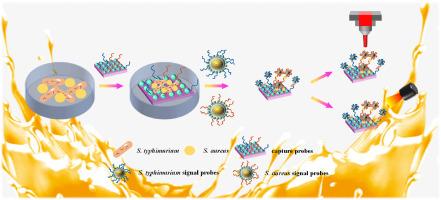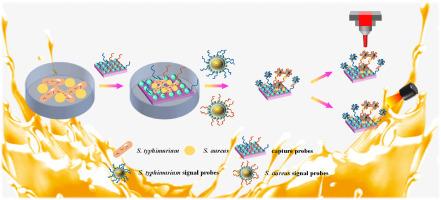一种用于鼠伤寒沙门菌和金黄色葡萄球菌选择性鉴定、灵敏检测和高效光热杀菌的多功能生物传感器
IF 6
2区 化学
Q1 CHEMISTRY, ANALYTICAL
引用次数: 0
摘要
背景食源性致病菌,如鼠伤寒沙门氏菌(S. type)和金黄色葡萄球菌(S. aureus),对人类健康构成严重威胁。准确识别、快速检测和有效灭活是早期诊断和治疗型葡萄球菌和金黄色葡萄球菌的关键。然而,到目前为止,大多数研究只集中在构建单一功能的s型和金黄色葡萄球菌检测或灭活的生物平台上。因此,开发一种多功能表面增强拉曼散射(SERS)生物传感器势在必行,该传感器既能对s型和金黄色葡萄球菌进行有效灭菌,又能同时实现敏感检测和选择性鉴定。结果设计并构建了一种基于“捕获探针/细菌/信号探针”夹层结构的多功能SERS生物传感器,可同时识别、检测和杀死s型和金黄色葡萄球菌。利用适体修饰的ZnO/Ag作为捕获探针,在复杂环境中准确地识别和捕获目标细菌。以Au@Ag-4-MPBA-Aptamer作为信号探针,提供相应细菌SERS“指纹”信息。讨论了夹层结构ZnO/Ag-Au@Ag SERS衬底的SERS增强机理。该三明治型SERS生物传感器具有较强的局部表面等离子体共振(LSPR)效应,对s型和金黄色葡萄球菌的检出限低至10 cfu/mL。此外,三明治型SERS生物传感器具有优异的光热转换效率(54.32%),可以在激光照射下对目标细菌进行光热杀伤。提出了一种基于三明治结构的双增强策略,利用电磁增强和化学增强的协同作用最大化SERS信号的灵敏度。SERS增强因子(EF)高达4.67×105。此外,三明治型SERS生物传感器不仅具有可忽略不计的细胞毒性,而且被证明是一种有前途的光热灭活食品样品中的s型和金黄色葡萄球菌的工具。本文章由计算机程序翻译,如有差异,请以英文原文为准。


A multifunctional biosensor for selective identification, sensitive detection and efficient photothermal sterilization of Salmonella typhimurium and Staphylococcus aureus
Background
The foodborne pathogens, e.g., Salmonella typhimurium (S. typ) and Staphylococcus aureus (S. aureus), pose a serious threat to human health. Accurate identification, rapid detection and efficient inactivation are crucial in the early diagnosis and treatment of S. typ and S. aureus. To date, however, the majority of studies have only concentrated on the construction of single-function biological platform for detection or inactivation of S. typ and S. aureus. Therefore, it is imperative to develop a multifunctional surface-enhanced Raman scattering (SERS) biosensor that can effectively sterilize S. typ and S. aureus while simultaneously achieving sensitive detection and selective identification.
Results
Herein, we designed and constructed a multifunctional SERS biosensor based on sandwich structure of “capture probe/bacteria/signal probe” in order to simultaneously identify, detect and kill S. typ and S. aureus. Aptamer-modified ZnO/Ag was used as a capture probe to accurately identify and capture the target bacteria in complex environments. Au@Ag-4-MPBA-Aptamer was employed as signal probe to provide the corresponding bacterial SERS “fingerprint” information. The SERS enhancement mechanism of the sandwich-structure ZnO/Ag–Au@Ag SERS substrate was discussed. The sandwich-type SERS biosensor exhibited the strong localized surface plasmon resonance (LSPR) effect and the detection limit for S. typ and S. aureus was as low as 10 cfu/mL. Furthermore, the sandwich-type SERS biosensor offered excellent photothermal conversion efficiency (54.32 %), enabling photothermal killing of target bacteria when exposed to laser irradiation.
Significance and novelty
A dual enhancement strategy based on a sandwich structure was proposed to maximize the sensitivity of SERS signals using synergistic action of electromagnetic enhancement and chemical enhancement. SERS enhancement factor (EF) was as high as 4.67 × 105. In addition, the sandwich-type SERS biosensor not only exhibited negligible cytotoxicity, but also was proved to be a promising tool for photothermally inactivate of S. typ and S. aureus in food samples.
求助全文
通过发布文献求助,成功后即可免费获取论文全文。
去求助
来源期刊

Analytica Chimica Acta
化学-分析化学
CiteScore
10.40
自引率
6.50%
发文量
1081
审稿时长
38 days
期刊介绍:
Analytica Chimica Acta has an open access mirror journal Analytica Chimica Acta: X, sharing the same aims and scope, editorial team, submission system and rigorous peer review.
Analytica Chimica Acta provides a forum for the rapid publication of original research, and critical, comprehensive reviews dealing with all aspects of fundamental and applied modern analytical chemistry. The journal welcomes the submission of research papers which report studies concerning the development of new and significant analytical methodologies. In determining the suitability of submitted articles for publication, particular scrutiny will be placed on the degree of novelty and impact of the research and the extent to which it adds to the existing body of knowledge in analytical chemistry.
 求助内容:
求助内容: 应助结果提醒方式:
应助结果提醒方式:


